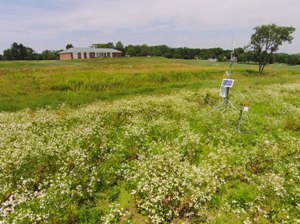Jul 22 2014
Bucknell University already maintains one of the most robust surface water monitoring networks in the country, and the only sensors collecting water quality data on the Susquehanna River year round.
 A solar powered weather station near the Bucknell Golf Club practice facility is the heart of Bucknell's new monitoring network on Miller Run.
A solar powered weather station near the Bucknell Golf Club practice facility is the heart of Bucknell's new monitoring network on Miller Run.
Now, the University is expanding that network to include a creek that winds through its campus in a project that could change the way stream monitoring and restoration is carried out statewide.
The endeavor — supported by both the Bucknell University Environmental Center's Watershed Sciences and Engineering Program (formerly the Susquehanna River Initiative) and a $270,000 Growing Greener grant from the Pennsylvania Department of Environmental Protection (DEP) — is an interdisciplinary effort bringing together faculty in the Environmental Center and the Department of Computer Science. Watershed Sciences and Engineering Program Director Ben Hayes and colleagues have installed a weather station and three stream guage stations along Miller Run, the stream that snakes its way around the Bucknell Golf Club and through campus. Meanwhile, Professor Alan Marchiori, computer science, is working with students to build a database and visualization tool to instantly display data from both the Miller Run sensors and similar units already in place in the Susquehanna.
"Bucknell had no automated tools to combine all of that data into one coherent visualization," Marchiori said. "That's where we came in. Our goal is to combine all of these data sources and create a visualization that makes it easy to understand the data."
Every 15 seconds, the new sensor array monitors a suite of hydro climactic variables — including about water depth, temperature, pH and dissolved oxygen at several locations on Miller Run — and transmits that information to a campus server using a wireless mesh network. At one sensor location, near the golf course, a cellular data modem provides a network connection through which the other sensors relay their data. The setup saves money, requiring only one cellular data plan for the whole network rather than one at each sensor location.
Together with summer research intern Gilbert Kim, Marchiori is building an online database that not only integrates the existing sensors in the Susquehanna and Miller Run, which were manufactured by two different companies, but that can also adapt to new sensors effortlessly. As the price of microprocessors and dataloggers continues to drop, Hayes envisions more and more groups participating in watershed monitoring, and he wants a system that can incorporate as much information as possible.
"The idea is that as we reduce the cost, we can crowdsource data from other universities, agencies and watershed groups who install a similar network," Hayes said. "Groups like the Chesapeake Bay Foundation, Trout Unlimited, or even retired science teachers and faculty can participate. They just need something that doesn't cost a fortune."
The monitoring project is also a preliminary step in restoring Miller Run to a more natural state — a long-term commitment of the University at large. As it stands, the stream is hardly a natural environment. From its headwaters near the golf course, Miller Run flows through underground pipes beneath the club's practice range, around private property built upon coal ash landfill, beneath a busy highway, through campus in concrete and riprap-lined channel and into Limestone Run, which empties into Susquehanna River. The first phase of the restoration effort is the planned daylighting of the stream passing through driving range, a project it will undertake in partnership with DEP and the U.S. Fish and Wildlife Service.
Hayes and Marchiori also foresee the technology they are developing for their project as having much larger implications, around campus, the state and even nationwide.
Marchiori sees the project as a model for sorting and analyzing other data collected around campus — from Bucknell's solar arrays, weather stations and building occupancy sensors — into one seamless and easy-to-navigate platform.
"It would allow us to do more sophisticated analysis of data," Marchiori said. "You could easily compare building energy consumption per square foot or per occupant; you could compare the dorms and see which are using more energy in real-time. Right now that would take a lot of extra effort in combining all of the data before doing the analysis."
"This is basically our prototype system," he added. "Once we build the infrastructure, we can go and add sensors. It's not that hard. The idea is to build something you can continue to add to."
Hayes noted that the project could also have a positive ripple effect far beyond campus, making real-time monitoring accessible to other groups and changing the way watershed restoration is done throughout Pennsylvania.
"DEP is very excited about what's going on here, because they give away millions of dollars in Growing Greener grants," he said. "They would love to see every project monitored and studied over the long term, but the cost and complexity of off-the-shelf monitoring systems makes that prohibitive for most projects. If Alan and I can develop this high-performance, low-cost monitoring network, we envision a day when DEP can say, 'As part of this stream restoration grant we want you to install a wireless network of instruments like Buckell did on Miller Run.'"